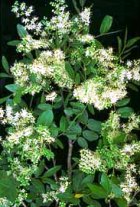
Plant Part: Resin
Extraction: Steam Distilled
Growing Practice: Ethical
Country of Origin: S. America
Odor Type: WOODY

Odor Characteristic: Copaiba balsam has a sweet, linalolic odor, woody with a spicy-fresh celery stalk aspect. It can sometimes have a aldehydic orange note reminiscent of neroli. Dry out is predominantly warm and sweet with the celery aspect and sweet neroli note.
Refractive Index: 1.49300 to 1.50000 @ 20.00 °C.
Specific Gravity: 0.88000 to 0.90700 @ 25.00 °C.
Appearance: pale yellow clear oily liquid, sometimes brown semi-transparent
BioChemical Class: Sesquiterpene
BioChemicals: In what could as well apply to other species, Hager's Handbuch lists δ-elemene, copaene, α- and β-cubebene, cyperene, α-bergamoten, β- and γ-elemene, β-farnesene, alloaromadendrene, α- and β-humulene,& beta;-bisabolene, α- and β-selinene, δ- and γ-cadinene, ar-curcumene, calamenene. From the wood, Langenheim (1981) reports the following diterpenoids: polyalthic acid; (-)-jkaur-16-en-19-oic acid, (-) 16 betakauren- 19-oic acid and eperu-8(20)-en-15,18-dioic acid. In 1980, Calvin published the chromatogram of products obtained from Copaiba oil.
Langenheim (1981) compares the sesquiterpenes of Hymenaea, shall we call it the "kerosene tree," and Copaifera, Calvin's "diesel tree.
CAS No: 8013-97-6
About the Plant
Copaifera langsdorffii comes from the family Fabaceae and is a medium-sized tropical tree indigenous cerrados of central Brazil to Amazonian South America, that can reach up to 45 feet high. It has small white flowers and small, oily fruits. A single tree can sometimes produce about 40 kilos of oleoresin annually.The essential oil is obtained from a high vacuum distillation (dry distillation) of the exudate resin in the ducts and cavities in the trunk.
History
The indigenous tribes in northwest Amazonia used the resin topically as a wound healer, to stop bleeding for skin sores and psoriasis. In Brazil, it has been used as a herbal medicine for the respiratory tract, including bronchitis and sinusitis), and as an anti-inflammatory and antiseptic for the urinary tract. Copaiba resin was first recorded in European medicine in 1625 (brought back from the New World by the Jesuits and called Jesuit's balsam) and has been used there since in the treatment of chronic cystitis, bronchitis, chronic diarrhea, and as a topical preparation for hemorrhoids. In the United States, it was an official drug in the U. S. Pharmacopeia from 1820 to 1910. Noted ethnobotanist and author Mark Plotkin reports that copaiba oil has been used in the United States as a disinfectant, diuretic, laxative, and stimulant-in addition to being used in cosmetics and soaps.Grieve (1931) describes the balsam plant as stimulant, diuretic, carminative, laxative; in large doses purgative, causing nausea, vomiting, strangury, bloody urine, and fever. A good remedy for chronic catarrh and bronchitis, as it assists expectoration and is antiseptic; given with advantage in leucorrhoea, chronic cystitis, diarrhea, and hemorrhoids. It is chiefly used in gonorrhea (though not advocated for chronic cases), often combined with cubebs and sandal. It has also been recommended externally for chilblains.
Perfumery: Copaiba balsam blends well with woody and floral elements in a perfume.![]()
The information provided on these pages is not a substitute for necessary medical care, nor intended as medical advice. Always keep aromatic extracts tightly closed and in a cool, dark place, out of reach of children. Never ingest aromatic extracts. Always dilute aromatic extracts when applying topically and avoid areas around eyes or mucous membranes. If redness or irritation occurs, stop using immediately and contact your health provider if necessary.![]()
all images and content copyright ©2000—2020 by suzumebachi design and samara botane





